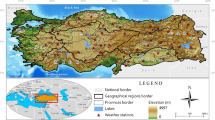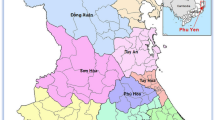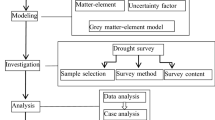Abstract
Regional agricultural drought vulnerability (RADV) is a complex problem caused by the interaction of various factors, and the combination of multiple dimensions of each subregion, factor index and time affects the RADV. Therefore, panel data should be used to reflect the actual situation of the region objectively and comprehensively. Current research on identifying key factors of affecting RADV is relatively scarce from the perspective of panel data. In view of this, in order to classify and identify the key factors, a new panel data grey combined method of comprehensive grey relational analysis (CGRA) and Max-CGRA clustering is proposed, which is applied to identify the key factors of RADV in China’s Henan Province. According to the identification results of key factors, the reasons for the change of RADV are further discovered, and the corresponding drought policies and countermeasures that need to be strengthened and controlled are presented. In addition, these results can also provide scientific basis for regional agricultural drought risk control.



Similar content being viewed by others
References
Acosta-Michlik LA, Kumar KSK, Klein RJT, Campe S (2008) Application of fuzzy models to assess susceptibility to droughts from a socio-economic perspective. Reg Environ Change 8:151–160
Aher S, Shinde S, Guha S, Majumder M (2017) Identification of drought in Dhalai river watershed using MCDM and ANN models. J Earth Syst Sci 126:21
Ahmadalipour A, Moradkhani H (2018) Multi-dimensional assessment of drought vulnerability in Africa: 1960–2100. Sci Total Environ 644:520–535
Alcamo J, Acosta-Michlik L, Carius A, Eierdanz F, Klein R, Kromker D, Tanzler D (2008) A new approach to quantifying and comparing vulnerability to drought. Reg Environ Change 8(4):137–149
Bhavani P, Roy PS, Chakravarthi V, Kanawade VP (2017) Satellite remote sensing for monitoring agriculture growth and agricultural drought vulnerability using long-term (1982–2015) climate variability and socio-economic data set. Proc Natl Acad Sci India Sect A Phys Sci 87:733–750
Brooks N, Adger WN, Kelly PM (2005) The determinants of vulnerability and adaptive capacity at the national level and the implications for adaptation. Glob Environ Change Hum Policy Dimens 15(2):151–163
Campana PE, Zhang J, Yao T, Andersson S, Landelius T, Melton F, Yan J (2018) Managing agricultural drought in Sweden using a novel spatially-explicit model from the perspective of water-food-energy nexus. J Clean Prod 197:1382–1393
Fraser EDG, Termansen M, Sun N, Guan D, Simelton E, Dodds P, Feng K, Yu Y (2008) Quantifying socioeconomic characteristics of drought-sensitive regions: evidence from Chinese provincial agricultural data. C R Geosci 340:679–688
Ha KD, Chulsang Y, Tae-Woong K (2011) Application of spatial EOF and multivariate time series model for evaluating agricultural drought vulnerability in Korea. Adv Water Resour 34(3):340–350
Jin JL, Zhang HY, Chen ML, Cui Y, Ning SW (2019) Evaluation and diagnosis of agricultural Drought vulnerability based on grey correlation and connection number coupling. J Catastrophol 34(1):1–7
Khazai B, Schulz C, Borst D (2013) An integrated indicator framework for spatial assessment of industrial and social vulnerability to indirect disaster losses. Nat Hazards 67:145–167
Kim SM, Kang MS, Jang MW (2018) Assessment of agricultural drought vulnerability to climate change at a municipal level in South Korea. Paddy Water Environ 16(4):699–714
Li AL (2016) Risk analysis of agricultural drought disaster: a case of Henan Province. North China University of Water Resources and Electric Power, Zhengzhou, pp 1–71
Li XM, Hipel KW, Dang YG (2015) An improved grey relational analysis approach for panel data clustering. Expert Syst Appl 42:9105–9116
Liu WJ, Zhang J, Jin MZ, Liu SF, Chang XY et al (2017) Key indices of the remanufacturing industry in China using a combined method of grey incidence analysis and grey clustering. J Clean Prod 168:1348–1357
Luo TY, Wu C, Duan LX (2018) Fishbone diagram and risk matrix analysis method and its application in safety assessment of natural gas spherical tank. J Clean Prod 174:296–304
Ma XM, Xiong SP, Li L, Zhang JJ, He JG (2005) Effects of soil moisture on photosynthetic characteristics of different specialized end-uses winter wheat at their later growth stages and on their yields. Chin J Appl Ecol 16(1):83–87
Mohamamdi R, Etminan A, Shooshtari L (2017) Statistical methods for identifying traits associated with high yield potential in durum wheat under drought conditions. Indian J Genet Plant Breed 77:513–523
Murthy CS, Laxman B, Sai MVRS (2015) Geospatial analysis of agricultural drought vulnerability using a composite index based on exposure, sensitivity and adaptive capacity. Int J Disaster Risk Reduct 12:163–171
Palchaudhuri M, Biswas S (2016) Application of AHP with GIS in drought risk assessment for Puruliya district, India. Nat Hazards 84:1905–1920
Pei W, Fu Q, Liu D, Li TX, Cheng K (2016) Assessing agricultural drought vulnerability in the Sanjiang Plain based on an improved projection pursuit model. Nat Hazards 82(1):683–701
Rajesh R, Ravi V (2015) Supplier selection in resilient supply chains: a grey relational analysis approach. J Clean Prod 86:343–359
Schneider T, Neumaier A (2001) Algorithm 808: ARFIT—a Matlab package for the estimation of parameters and eigenmodes of multivariate autoregressive models. ACM Trans Math Softw 27(1):58–65
Shahid S, Behrawan H (2008) Drought risk assessment in the western part of Bangladesh. Nat Hazards 46:391–413
Sharma U, Patwardhan A (2008) Methodology for identifying vulnerability hotspots to tropical cyclone hazard in India. Mitig Adapt Strateg Glob Change 13(7):703–717
Shewmake S (2008) Vulnerability and the impact of climate change in South Africa’s Limpopo River Basin. International Food Policy Research Institute, Washington, DC, USA
Simelton E, Fraser EDG, Termansen M, Forster PM, Dougill AJ (2009) Typologies of crop-drought vulnerability: an empirical analysis of the socio-economic factors that influence the sensitivity and resilience to drought of three major food crops in China (1961–2001). Environ Sci Policy 12(4):438–452
Simelton E, Fraser EDG, Termansen M, Benton TG, Gosling SN, South A, Arnell NW, Challinor AJ, Dougill AJ, Forster PM (2012) The socioeconomics of food crop production and climate change vulnerability: a global scale quantitative analysis of how grain crops are sensitive to drought. Food Secur 4(2):163–179
Varazanashvili O, Tsereteli N, Amiranashvili A, Tsereteli E et al (2012) Vulnerability, hazards and multiple risk assessment for Georgia. Nat Hazards 64(3):2021–2056
Vargas J, Paneque P (2017) Methodology for the analysis of causes of drought vulnerability on the River Basin scale. Nat Hazards 89:609–621
Wang YH, Zuo WC (2018) Research on multi-index grey clustering approach based on adaptive weight for panel data. J Grey Syst 30:13–32
Wang ZQ, He F, Fang WH, Liao YF (2013) Assessment of physical vulnerability to agricultural drought in China. Nat Hazards 67(2):645–657
Wang JJ, Hipel KW, Dang YG (2017) An improved grey dynamic trend incidence model with application to factors causing smog weather. Expert Syst Appl 87:240–251
Wilhelmi OV, Wilhite DA (2002) Assessing vulnerability to agricultural drought: a Nebraska case study. Nat Hazards 25(1):37–58
Wilhite DA (1996) A methodology for drought preparedness. Nat Hazards 13:229–252
Wu JJ, He B, Lu AF, Zhou L, Liu M, Zhao L (2011) Quantitative assessment and spatial characteristics analysis of agricultural drought vulnerability in China. Nat Hazards 56:785–801
Wu D, Yan DH, Yang GY, Wang XG, Xiao WH, Zhang HT (2013) Assessment on agricultural drought vulnerability in the Yellow River basin based on a fuzzy clustering iterative model. Nat Hazards 67(2):919–936
Wu H, Qian H, Chen J, Huo CC (2017a) Assessment of agricultural drought vulnerability in the Guanzhong Plain, China. Water Resour Manag 31:1557–1574
Wu JJ, Geng GP, Zhou HK, Liu JH, Wang QF, Yang JH (2017b) Global vulnerability to agricultural drought and its spatial characteristics. Sci China Earth Sci 60(5):910–920
Wu JS, Lin X, Wang MJ, Peng J, Tu YJ (2017c) Assessing agricultural drought vulnerability by a VSD model: a case study in Yunnan Province, China. Sustainability 9:918
Yang XH, Di CL, He J, Zhang J, Li YQ (2015) Integrated assessment of water resources vulnerability under climate change in Haihe River Basin. Int J Numer Meth Heat Fluid Flow 25(8):1834–1844
Yue YJ, Li J, Ye XY, Wang ZQ, Zhu AX, Wang JA (2015) An EPIC model-based vulnerability assessment of wheat subject to drought. Nat Hazards 78(3):1629–1652
Zhao X, Barber S, Taylor CC, Milan Z (2018) Classification tree methods for panel data using wavelet-transformed time series. Comput Stat Data Anal 127:204–216
Zou ZH, Yun Y, Sun JN (2006) Entropy method for determination of weight of evaluating indicators in fuzzy synthetic evaluation for water quality assessment. J Environ Sci 18(5):1020–1023
Acknowledgements
The authors are very grateful to the referees for their insightful and constructive comments and suggestions that have led to an improved version of this paper. This paper is supported by National Natural Science Foundation of China (Nos. 71771119, 71371098, 71701105), Postgraduate Research and Practice Innovation Program of Jiangsu Province (SJKY19_0143), Key Research Project of Social Science Fund in Jiangsu Province (No. 16GLA001) and Fundamental Research Funds for the Central Universities (No. 2017301).
Author information
Authors and Affiliations
Corresponding author
Additional information
Publisher's Note
Springer Nature remains neutral with regard to jurisdictional claims in published maps and institutional affiliations.
Rights and permissions
About this article
Cite this article
Sun, H., Dang, Y. & Mao, W. Identifying key factors of regional agricultural drought vulnerability using a panel data grey combined method. Nat Hazards 98, 621–642 (2019). https://doi.org/10.1007/s11069-019-03722-0
Received:
Accepted:
Published:
Issue Date:
DOI: https://doi.org/10.1007/s11069-019-03722-0




